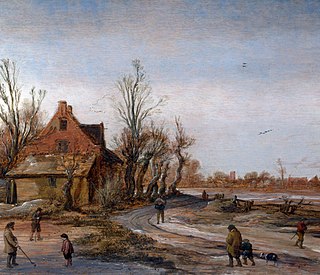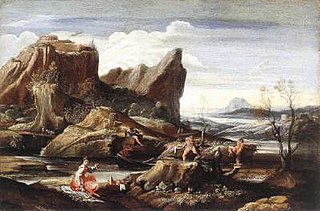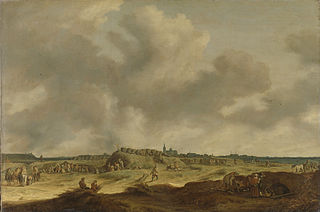

Pieter Schoubroeck, or Schaubroeck (ca.1570 – May 10, 1607), was a German landscape painter of the Frankenthal school.


Pieter Schoubroeck, or Schaubroeck (ca.1570 – May 10, 1607), was a German landscape painter of the Frankenthal school.
Schoubroeck was born at Hessheim. His father was of Flemish origin and his mother Clarken de Wale was also from the Southern Netherlands. [1] According to the RKD he was active in Italy in 1595, Neurenberg in 1597-1600, and moved to Frankenthal in 1601. [2] He painted landscapes and is considered a member of the school of Frankenthal. [2] The school of Frankenthal [3] included the painters Gillis van Coninxloo, Anton Mirou, and Hendrik van der Borcht the elder & son. [4] He died in Frankenthal.

Nicolaes Pieterszoon Berchem was a highly esteemed and prolific Dutch Golden Age painter of pastoral landscapes, populated with mythological or biblical figures, but also of a number of allegories and genre pieces.

Gillis van Coninxloo was a Flemish painter of landscapes who played an important role in the development of Northern landscape art at the turn of the 17th century. He spent the last 20 years of his life abroad, first in Germany and later in the Dutch Republic.

Pieter Claesz was a Dutch Golden Age painter of still lifes.

Esaias van de Velde was a Dutch landscape painter.

Bartholomeus Breenbergh was a Dutch Golden Age painter of Italian and Italianate landscapes, in Rome (1619-1630) and Amsterdam (1630-1657).

Hendrik van der Borcht the Elder or Hendrick van der Borcht the Elder (1583 - 26 July 1651 was a Flemish-German engraver and painter of portraits, still lifes of antiquities, flowers and fruit and landscapes. He was also an eminent antiquarian. He was mainly active in Germany to which his family had emigrated for religious reasons.

Francois (Frans) Verwilt was as a Dutch Golden Age landscape painter.

Pieter de Molijn was a Dutch Golden Age painter and engraver of English birth and Flemish descent.

Pieter Jansz van Asch was a Dutch Golden Age painter.

Pieter de Neyn, or Deneyn was a Dutch Golden Age painter.

Gabriel, or Govert van der Leeuw (1645–1688), was a Dutch Golden Age landscape painter.

Pieter Wouwerman was a Dutch Golden Age landscape painter.

Antoine, or Anton Mirou, was a Flemish Baroque landscape painter of the Frankenthal school. He is known for his wooded and rocky landscapes and landscapes with populated villages. He was also a topographical draftsman whose views were widely disseminated through prints.

Pieter Mulier I, was a Dutch Golden Age painter.

Georgius Jacobus Johannes van Os, was a 19th-century painter from the Northern Netherlands.

Jan Gabrielsz. Sonjé, was a Dutch Golden Age landscape painter.
Pieter van der Leeuw was a Dutch Golden Age landscape painter.
Jan Vaillant, was a Dutch Golden Age painter.

Hendrik Gijsmans or Egidius Gijsmans was a Flemish painter, draftsman, tapestry designer and mayor. After training in his native Mechelen, he moved to Antwerp where he probably worked in the workshop of Gillis Mostaert. As a Protestant he left Antwerp after the fall of the city to the Spanish in 1585. He settled in Frankenthal in 1586 where he joined a large group of other Flemish émigré artists. He later became the mayor of Frankenthal. The artist’s work has only recently been rediscovered after he was identified with an anonymous artist referred to as Anonymous Fabriczy of whom a collection of about 50 drawings are held in the Staatsgalerie Stuttgart.

Lot and His Daughters is a c.1520 oil on panel painting. It was produced by an unknown artist working in Leyden or Antwerp, though it was long attributed to Lucas van Leyden. It is now in the Louvre, having entered its collection in 1900.